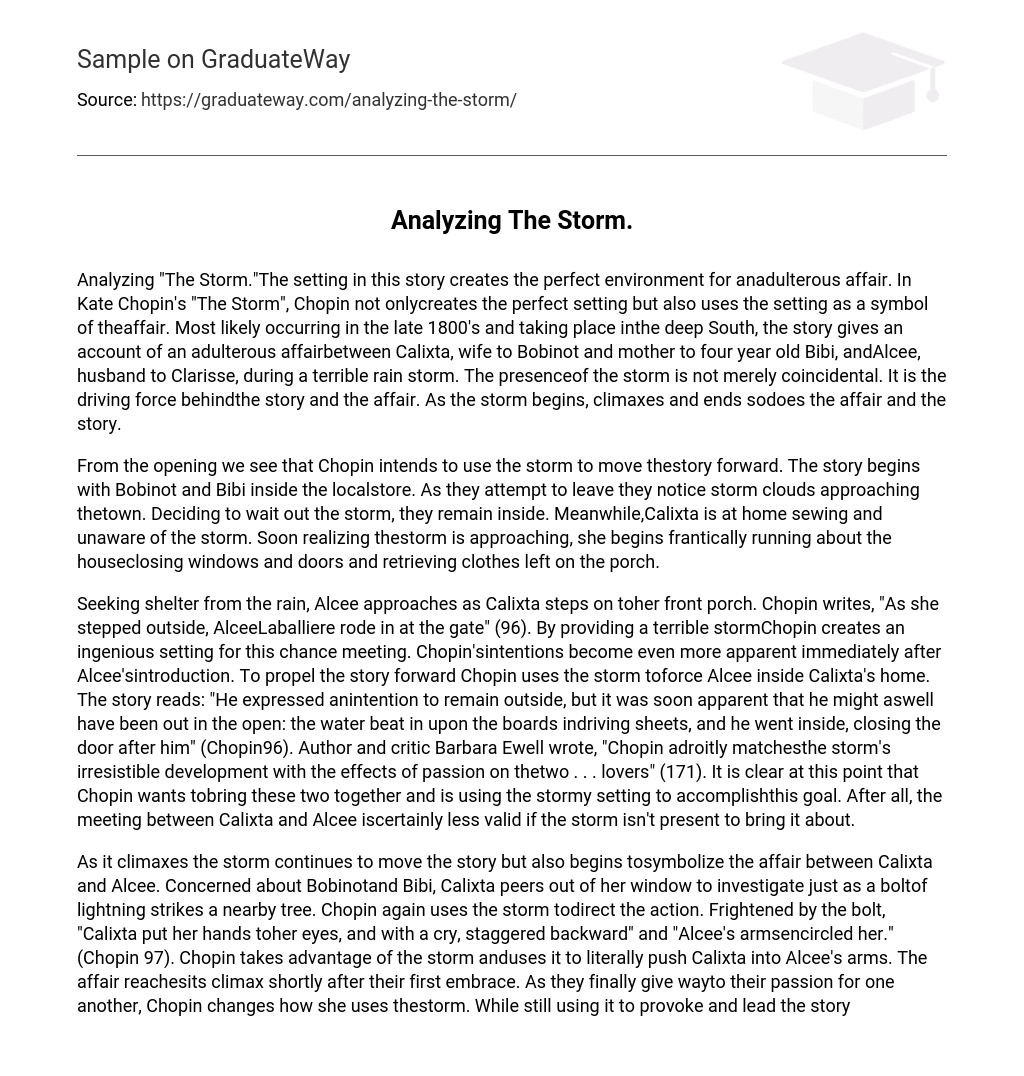The setting in this story creates the perfect environment for anadulterous affair. In Kate Chopin’s “The Storm”, Chopin not onlycreates the perfect setting but also uses the setting as a symbol of theaffair. Most likely occurring in the late 1800’s and taking place inthe deep South, the story gives an account of an adulterous affairbetween Calixta, wife to Bobinot and mother to four year old Bibi, andAlcee, husband to Clarisse, during a terrible rain storm. The presenceof the storm is not merely coincidental. It is the driving force behindthe story and the affair. As the storm begins, climaxes and ends sodoes the affair and the story.
From the opening we see that Chopin intends to use the storm to move thestory forward. The story begins with Bobinot and Bibi inside the localstore. As they attempt to leave they notice storm clouds approaching thetown. Deciding to wait out the storm, they remain inside. Meanwhile,Calixta is at home sewing and unaware of the storm. Soon realizing thestorm is approaching, she begins frantically running about the houseclosing windows and doors and retrieving clothes left on the porch.
Seeking shelter from the rain, Alcee approaches as Calixta steps on toher front porch. Chopin writes, “As she stepped outside, AlceeLaballiere rode in at the gate” (96). By providing a terrible stormChopin creates an ingenious setting for this chance meeting. Chopin’sintentions become even more apparent immediately after Alcee’sintroduction. To propel the story forward Chopin uses the storm toforce Alcee inside Calixta’s home.
The story reads: “He expressed anintention to remain outside, but it was soon apparent that he might aswell have been out in the open: the water beat in upon the boards indriving sheets, and he went inside, closing the door after him” (Chopin96). Author and critic Barbara Ewell wrote, “Chopin adroitly matchesthe storm’s irresistible development with the effects of passion on thetwo . . . lovers” (171). It is clear at this point that Chopin wants tobring these two together and is using the stormy setting to accomplishthis goal. After all, the meeting between Calixta and Alcee iscertainly less valid if the storm isn’t present to bring it about.
As it climaxes the storm continues to move the story but also begins tosymbolize the affair between Calixta and Alcee. Concerned about Bobinotand Bibi, Calixta peers out of her window to investigate just as a boltof lightning strikes a nearby tree. Chopin again uses the storm todirect the action. Frightened by the bolt, “Calixta put her hands toher eyes, and with a cry, staggered backward” and “Alcee’s armsencircled her.” (Chopin 97).
Chopin takes advantage of the storm anduses it to literally push Calixta into Alcee’s arms. The affair reachesits climax shortly after their first embrace. As they finally give wayto their passion for one another, Chopin changes how she uses thestorm. While still using it to provoke and lead the story she also usesthe storm to symbolize and confirm the romance. One critic noted that”The course of their passion parallels that of the storm . . . ” (Skaggs61).
As the storm reaches it’s climax Chopin refers to the lovers:”They did not heed the crashing torrents and the roar of the elementsmade her laugh as she lay in his arms” (97). By describing the stormduring the climax between Calixta and Alcee, Chopin is implying thattheir passion equals the intensity of the storm. The storm continues tolead them but also symbolizes the passion they share.
The storm begins to pass as the story nears its end, taking with itAlcee and the affair. The story resumes with Calixta and Alcee enjoyingtheir last few moments together. Chopin continues her effort to allowthe storm to dictate the sequence of events. To convey the status ofthe affair she again refers to the storm. By stating, “The rain wasover” Chopin ends the sexual affair between Calixta and Alcee (Chopin98).
This is also another example of Chopin using the storm to symbolizethe affair between the main characters. As the storm ends and Alceeleaves, we see the return of Bobinot and Bibi. Calixta, more thangrateful to see the two, greets them well and they all sit down tosupper. Alcee writes his wife, Clarrise, who is vacationing andlovingly tells her that he is doing well and to not hurry back. Clarrise returns his letter explaining that she is pleased to hear thisand that she will indeed stay longer. It is the last sentence in thestory that makes the final comparison to the storm. “So the stormpassed and everyone was happy” (Chopin 99).
In one sentence Chopin endsthe storm, the affair, and the story. This seems to confirm that Chopinintended to align the sequence of events with the development of thestorm. It is also an excellent example of the symbolism used in thestory. The denotation of the last sentence is that the characters arehappy at the passage of the storm. However, the connotation for Calixtaand Alcee is much deeper, implying that their happiness is derived fromthe passion they shared during the storm.
And so the story ends with everyone happy and satisfied. The storm isan effective setting and a more than adequate symbol. From bringing thelovers together, to describing their sexual climax and then quietly andstylishly ending the affair. It is the description of the storm thatcreates the foundation and intensity of the interlude between Calixtaand Alcee. Carrying it from beginning, climax and end, the storm iswhat makes it all possible.





